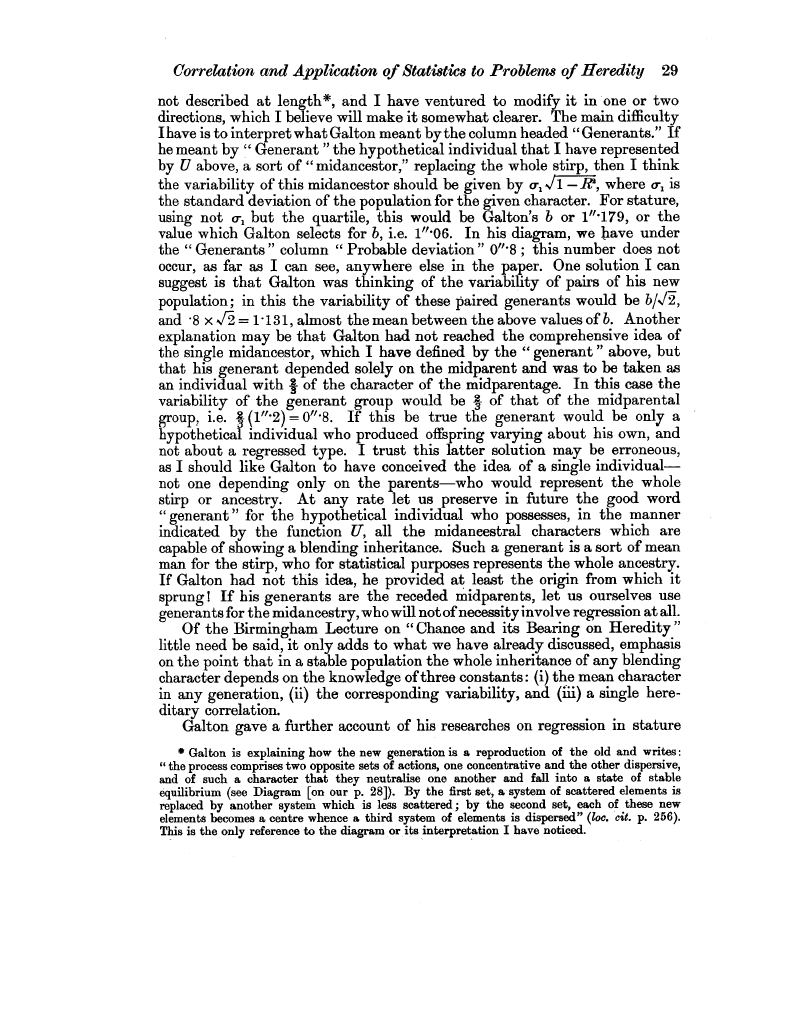| ||||||

OCR Rendition - approximate
Correlation and Application of Statistics to Problems of Heredity 29 not described at length*, and I have ventured to modify it in one or two directions, which I believe will make it somewhat clearer. The main difficulty I have is to interpret what Galton meant by the column headed "Generants." If he meant by " Generant " the hypothetical individual that I have represented by U above, a sort of " midancestor," replacing the whole stirp, then I think the variability of this midancestor should be given by a-, %/1-R', where a, is the standard deviation of the population for the given character. For stature, using not o, but the quartile, this would be Galton's b or 1"•179, or the value which Galton selects for b, i.e. 1`06. In his diagram, we have under the " Generants " column " Probable deviation " 0"•8 ; this number does not occur, as far as I can see, anywhere else in the paper. One solution I can suggest is that Galton was thinking of the variability of pairs of his new population; in this the variability of these paired generants would be b/,/-2, and •8 x ,/_92 =1.131, almost the mean between the above values of b. Another explanation may be that Galton had not reached the comprehensive idea of the single midancestor, which I have defined by the "generant " above, but that his generant depended solely on the midparent and was to be taken as an individual with I of the character of the midparentage. In this case the variability of the generant group would be 3 of that of the midparental group, i.e. 3 (1"•2) = 0"•8. If this be true the generant would be only a hypothetical individual who produced offspring varying about his own, and not about a regressed type. I trust this latter solution may be erroneous, as I should like Galton to have conceived the idea of a single individualnot one depending only on the parents-who would represent the whole stirp or ancestry. At any rate let us preserve in future the good word Cc generant " for the hypothetical individual who possesses, in the manner indicated by the function U, all the midaneestral characters which are capable of showing a blending inheritance. Such a generant is a sort of mean man for the stirp, who for statistical purposes represents the whole ancestry. If Galton had not this idea, he provided at least the origin from which it sprung ! If his generants are the receded midparents, let us ourselves use generants for the midancestry, who will not of necessity involve regression at all. Of the Birmingham Lecture on "Chance and its Bearing on Heredity " little need be said, it only adds to what we have already discussed, emphasis on the point that in a stable population the whole inheritance of any blending character depends on the knowledge of three constants : (i) the mean character in any generation, (ii) the corresponding variability, and (iii) a single hereditary correlation. Galton gave a further account of his researches on regression in stature * Galton is explaining how the new generation is a reproduction of the old and writes ~° the process comprises two opposite sets of actions, one concentrative and the other dispersive, and of such a character that they neutralise one another and fall into a state of stable equilibrium (see Diagram [on our p. 28]). By the first set, a system of scattered elements is replaced by another system which is less scattered ; by the second set, each of these new elements becomes a centre whence a third system of elements is dispersed" (loc. cit. p. 256). This is the only reference to the diagram or its interpretation I have noticed.
|